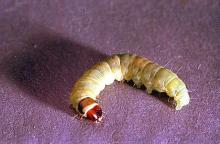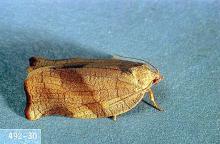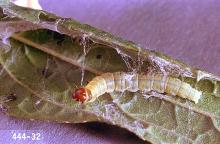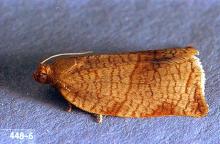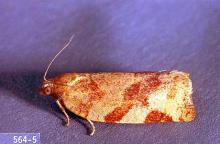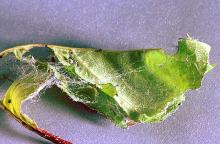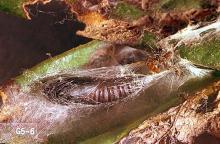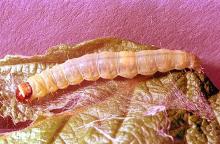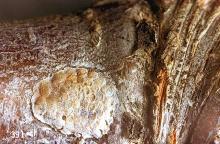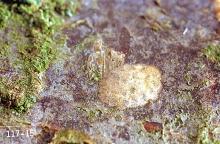European or filbert leafroller (Archips rosana)
Fruittree leafroller (Archips argyrospila)
Obliquebanded leafroller (Choristoneura rosaceana)
Pandemis leafroller (Pandemis pyrusana)
Pest description and crop damage There are several species of leafroller pests of tree fruits within the family Tortricidae. They all cause similar damage to the trees, but differ in their appearance and, more importantly, in their life cycle. The principal leafroller pests of fruit trees can be divided into single-generation moths, such as the fruittree leafroller and the European leafroller, and two-generation moths, such as the obliquebanded leafroller and pandemis leafroller. Adults of these species vary from fawn-color to dark brown. There are distinctive bands or mottling on the wings. Wingspans range from 0.5 to one inch. The larvae of these species are all green caterpillars with a light brown to black head, depending on the species. Pandemis larvae are green with a green or brown head. Obliquebanded leafroller larvae are similar to pandemis larvae, except the head is dark brown to black.
As the name leafroller implies, the larvae roll and tie leaves together for shelter and feeding. They thrash about when disturbed and may drop from the leaf suspended by a silken thread. Feeding on growing points on young plants can promote undesirable branching. Pre-bloom leafroller feeding within the cluster results in fruit abortion or deeply scarred fruit. Larvae also roll new leaves. Young larvae are tiny and notoriously difficult to sample, but they are typically most damaging because of feeding on developing fruitlets. The later life stages are evident as the caterpillars reach maximum size and the number of damaged leaves increases. Mature leafroller larvae often move to a new leaf just prior to pupation. By this point, any damage to fruit is complete and it is better to allow natural enemies to reproduce on the mature larvae than to attempt treating the population. A large complex of predators, parasitoid wasps, and parasitoid flies (Tachinidae) attack leafroller larvae.
Biology and life history The single-generation leafrollers overwinter as egg masses on twigs and branches. Eggs hatch in spring as buds are opening until petal fall. The larvae feed for four to six weeks, then pupate in the rolled leaves and emerge as moths in early summer. The overwintering eggs are laid in July.
Two-generation leafrollers overwinter as immature larvae under the bark on scaffold branches of a variety of host plants. Larvae may feed during warm periods in winter, but become active in spring with onset of new growth. They feed for several weeks, then pupate in rolled leaves. Adult moths generally emerge around May and lay eggs for the next generation. The next generation hatches in early summer and can cause considerable fruit injury as the larvae will settle and feed in fruit clusters especially where fruit are touching. Pandemis and obliquebanded leafrollers overwinter as larvae and have two generations per year. Fruittree and European leafrollers overwinter as eggs and have one generation per year. Eggs hatch in the prebloom period, and larvae mature by late May.
Pest monitoring Observe early spring growth for rolled leaves and feeding damage in fruit clusters and on new growth. Adults of these leafrollers may be monitored with pheromone traps to establish biofix for phenology models which have been developed for obliquebanded and pandemis leafrollers.
Management-biological control
Very low temperatures in winter significantly reduce overwintering populations of larvae. Spiders and parasitic wasps, as well as predators like the brown lacewing, greatly reduce leafroller populations throughout the year.
Management-cultural control
Fruit thinning can reduce problems significantly with some leafrollers. Thin fruit clusters to a single fruit. Hand-pick rolled leaves containing larvae or pupae.
Management-chemical control: HOME USE
Dormant-season sprays
Single-generation leafrollers that overwinter as eggs can be controlled with dormant oil sprays.
- superior-type oil-Some formulations OMRI-listed for organic use.
Growing-season sprays
- azadirachtin (neem oil)-Products containing neem extract may be phytotoxic to some pear cultivars. Some formulations are OMRI-listed for organic use.
- Bacillus thuringiensis var. kurstaki-Some formulations are OMRI-listed for organic use.
- bifenthrin-Highly toxic to bees.
- carbaryl-Highly toxic to bees.
- gamma-cyhalothrin-Highly toxic to bees.
- insecticidal soap-Some formulations OMRI-listed for organic use.
- kaolin-Applied as a spray to leaves, stems, and fruit, it acts as a repellant to some insect pests. Some formulations are OMRI-listed for organic use.
- lambda-cyhalothrin-Highly toxic to bees.
- malathion-Highly toxic to bees.
- permethrin-Highly toxic to bees.
- plant-derived essential oils-Some have shown efficacy against leafrollers. Some formulations are OMRI-listed for organic use.
- pyrethrins (often as a mix with other ingredients) -Highly toxic to bees. Some formulations are OMRI-listed for organic use.
- spinosad-Some formulations are OMRI-listed for organic use.
- zeta-cypermethrin-Highly toxic to bees.
Management-chemical control: COMMERCIAL USE
- Bacillus thuringiensis var. kurstaki (Dipel, Javelin)-Check label for rates. REI 4 hr. PHI 0 day. This biologically derived material acts slowly and requires good coverage and multiple applications in order to be effective. Apply when forecast calls for warm daily temperatures. Bt is less effective in cool weather when larvae are not actively feeding. Some formulations are OMRI-listed for organic use.
- chlorantraniliprole (Altacor) at 3 to 4.5 oz/A. REI 4 hr. PHI 5 days. Do not exceed 9 oz/A per season.
- cyantraniliprole (Exirel) at 10 to 17 fl oz/A. REI 12 hr. PHI 3 days. Do not exceed three applications per season.
- methoxyfenozide (Intrepid 2F) at 16 fl oz/A. REI 4 hr. PHI 14 days. Do not exceed 64 fl oz/A per season.
- spinetoram (Delegate WG) at 4.5 to 7 oz/A. REI 4 hr. PHI 7 days. Do not exceed four applications or 28 oz/A per season.
- spinosad (Entrust SC) at 6 to 10 fl oz/A. REI 4 hr. PHI 7 days. Do not exceed 29 fl oz/A per year. OMRI-listed for organic use.
Resistance management Leafrollers can develop resistance rapidly to chemical controls. Alternate chemistries and modes of action.


